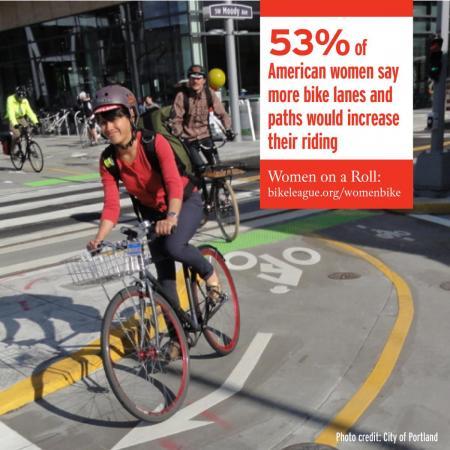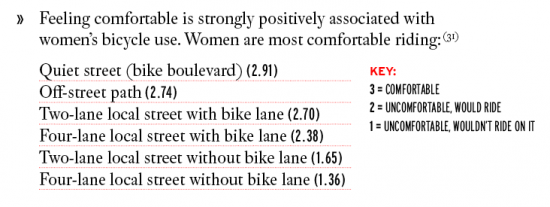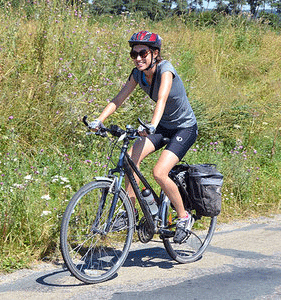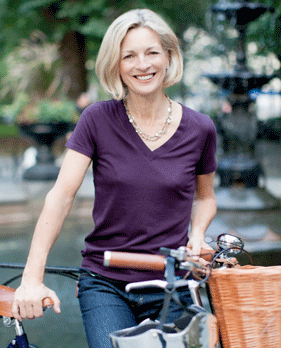DISCOVER YOUR LOCAL BICYCLING COMMUNITY
Find local advocacy groups, bike shops, instructors, clubs, classes and more!
Increased Comfort = More Women Biking
 Closing the gender gap in American bicycling isn’t as simple as painting more bike lanes. But, according to the first report from Women Bike, making biking more comfortable is one of the most important components in increasing female ridership.
Closing the gender gap in American bicycling isn’t as simple as painting more bike lanes. But, according to the first report from Women Bike, making biking more comfortable is one of the most important components in increasing female ridership.
For Women on a Roll — a first-of-its kind publication — we reached out to dozens of organizations and read hundreds of pages of research to identify the 5 Cs of Women’s Bicycling — and Comfort clearly rose to the top.
As Rutger’s researcher John Pucher puts it, making cycling “irrestible“ is one of main reasons women take 55% of bike trips in the Netherlands, but only 24% in the United States. It’s why we see some of the highest rates of women’s ridership in our top Bicycle Friendly Communities, like Portland, San Francisco and Philadelphia, where strategic investments are making bicycling more appealing. In fact, 2/3 of American women say their “community would be a better place to live if bicycling were safer and more comfortable.”
So what does that mean at the street level? According to our report:
- More than half of American women say more bike lanes and bike paths would encourage them to start or increase their riding
- Better facilities get more women on wheels: 94% of women in Portland said separated bike lanes made their ride safer
- Studies in Los Angeles, Philadelphia and New Orleans all show dramatic increases in female ridership after the installation of bike lanes
- Women will travel an additional 5 minutes more than men to access a bicycle facility
- Feeling comfortable is one of the most important factors in encouraging women to ride — and it’s not just bike lanes…
 So, while it’s not a silver — or green — bullet, infrastructure is vitally important.
So, while it’s not a silver — or green — bullet, infrastructure is vitally important.
 “In our Philly bike counts, we’ve noticed a much smaller gender gap on streets with bike infrastructure — specifically standard and buffered bike lanes — than those without,” says Katie Monroe, founder of the Women Bike PHL initiative at the Bicycle Coalition of Greater Philadelphia. “Despite being a really confident urban cyclist, I routinely go out of my way to avoid the hassle of annoyed motorists trying to squeeze around me; I love getting to pick my pace and smell the roses!”
“In our Philly bike counts, we’ve noticed a much smaller gender gap on streets with bike infrastructure — specifically standard and buffered bike lanes — than those without,” says Katie Monroe, founder of the Women Bike PHL initiative at the Bicycle Coalition of Greater Philadelphia. “Despite being a really confident urban cyclist, I routinely go out of my way to avoid the hassle of annoyed motorists trying to squeeze around me; I love getting to pick my pace and smell the roses!”
“And I’ve seen firsthand how important that sense of comfort is for new bicyclists getting started, regardless of gender,” she adds “It’s exciting to ride down Spruce or Pine streets and feel like the folks I’m sharing those buffered lanes with are a more accurate reflection of our diverse city. We still have a lot of work to do to keep that trend going — both in terms of expanding infrastructure and diversifying the bike movement in general — but creating comfortable spaces to ride is an indispensable piece of the puzzle.”
“I moved to Portland in 1995 and instantly started using my bike to get around,” says Janis McDonald, director of the city’s Women on Bikes program. “I loved that I could get anywhere I needed to go and biking made me feel strong and independent. Eighteen years later, though, I’ve found that I ride very differently. I still use my bike to get where I need to go but I do so at a slower speed. I ride in bike lanes, but what I find most comfortable and enjoyable are Portland’s neighborhood greenways — local streets with lower traffic and speeds that prioritize people walking and biking. Not only is the traffic slower with fewer cars, but I also ride at a casual speed without drivers and other bicyclists whizzing pass me.”
“I started the City of Portland’s Women on Bikes program nine years ago to create a a comfortable setting for women to learn and practice bike handling skills, maintenance and route planning,” she adds. “On the guided bike rides, I show off bike infrastructure and explain how to use it. We have lots of neighborhood greenways that I’ve introduced to women — and they love the feeling of riding on the greenways. When we do ride in bike lanes and then turn onto a neighborhood greenway, you can feel the exhales. There’s laughter and conversation as they ride next to each other. I still consider myself a strong and fearless bike rider, but now I’ll take the long way home if it means I can have a more pleasant, comfortable ride.”
 “In 2010, I discovered the protected bike lane on Ninth Avenue,” says Susi Wunsch, a New York City resident and founder of Velojoy.com. “To me, it signaled the city’s commitment to making a place for cyclists on our streets, and it made me feel safer. I’ve been happily using my bicycle for daily transportation ever since.”
“In 2010, I discovered the protected bike lane on Ninth Avenue,” says Susi Wunsch, a New York City resident and founder of Velojoy.com. “To me, it signaled the city’s commitment to making a place for cyclists on our streets, and it made me feel safer. I’ve been happily using my bicycle for daily transportation ever since.”
Wunsch didn’t just join the ranks in the bike lanes – she became an evangelist for cycling lifestyle, launching velojoy.com, a site dedicated to attracting more people to riding bicycles by demystifying and celebrating the joys of two-wheeled transportation. “What gets lost sometimes in the discussion about bicycling is what’s most elemental: the fun and freedom of it,” she adds.
As Women on a Roll highlights, comfort and convenience are elemental in making biking appealing to more women. Join us on our next Women Bike webinar this Thursday, August 29, at 1 p.m. Eastern as we explore these topics with two top researchers in the field: Jennifer Dill of Portland State University, and Susan Handy from the University of California-Davis.
Click here to register — and share the meme below!
